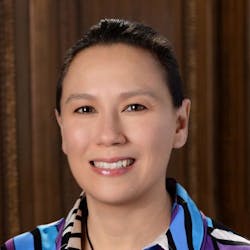In an April 20 talk to the National Association of ACOs, Elizabeth Fowler, J.D., Ph.D., the recently named director of the Center for Medicare and Medicaid Innovation (CMMI), said the organization is at a “crossroads,” and is undergoing a strategic evaluation to determine how its alternative payment models can have a transformative impact on the healthcare delivery system. She added that CMMI will be looking at models with a health equity lens.
Fowler began her talk by noting that the pandemic has shown us how far we have to go by revealing some of our biggest shortcomings. “COVID exposed vast racial and ethnic disparities in the health system and the care it provides, and it also demonstrated the shortcomings of fee for service when volume drops precipitously,” she said.
She then turned to some lessons learned from the 10 years of CMMI’s existence. Fowler noted that health system transformation is not easy and it is an iterative process. “Ultimately, at CMMI we want our alternative care models to position participants for success,” she said, adding that sometimes that means speeding up when there's an opportunity, and sometimes it means taking a break to ensure that a forthcoming model can realistically deliver on what's intended and that it's the strongest option based on evidence and data.
CMMI has recently put several models on hold for additional review, including Primary Care First and Geographic Direct Contracting models. Others have been delayed, including the Kidney Care Choices and the Chart ACO track.
“We've also walked back some changes to models like in the case of the Part D payment modernization model,” Fowler said. “I understand that, collectively, these announcements may have led to questions about where the center is headed next. And I want to be clear that our commitment to value-based care has never been stronger. We want the CMS Innovation Center to work to lower costs, improve quality of patient care, and better align payment systems to promote patient-centered practices. But we also need to be honest about the nature of innovation — that not everything is going to be a home run. Some things will work, others won't. And we need to be agile. True innovation means failing until we get things right. And it's just as important to learn from what doesn't work, and be transparent about those findings so we can continue to refine, evolve and grow.”
Fowler called this moment a critical juncture in the path toward value-based care. Speaking frankly, she said that over the last 10 years since the center was established, “we've lost some consensus in the stakeholder community about what we're trying to achieve and where we're heading. Is cost savings the most important measure of success? Or does quality improvement count just as much? Is risk bearing among providers the key to unlocking value? And at CMMI, is the ultimate goal expanding a model to become a permanent part of Medicare, or is healthcare transformation the ultimate goal? It could be both, but I think that in the time I have at CMMI I want to take a look at these questions and think about the bigger-picture issue and focus on longer-term health system goals.”
She asked the NAACOS membership for their patience as the new CMMI leadership takes time to review the portfolio of models, make adjustments where necessary, and make sure that the path forward is sustainable and meaningful.
Fowler said she is working with CMMI senior leadership to develop and implement a work plan based on shared priorities, including advancing health equity. “I plan to consider health equity in every stage of our models from model development to participant recruitment through model evaluation,” she added.
That equity work begins with collecting, reporting and using data on race and ethnicity. “It should be a requirement of all providers. It's certainly going to be a part of all the models developed going forward,” she said, adding that we need to think about developing, testing and scaling models that reduce disparities.
In addition, CMMI will look at expanding its reach into Medicaid and engaging other payers. “I think we need to do a better job with multi-payer alignment,” she said. CMMI will also work on other Biden administration priorities, including prescription drug pricing.
In a Q&A session following her talk, Clif Gaus, Sc.D., president and CEO of NAACOS, asked Fowler about recommendations that CMMI offer fewer but more strategically directed innovation models.
“I think the recommendations are coming to do fewer models and concentrate on certain areas because the landscape has gotten a lot more complex. The models overlap. People are competing for the same beneficiaries. It's a very complicated process, and the evaluations are getting harder and harder to do when models overlap in the same area,” Fowler said. “A lot of what we're we've done has been aimed towards certification of models to become a permanent part of Medicare. And in trying to get a model certified, it really does suggest a very specific model design and a very specific way of thinking about evaluations and the assessment by the actuaries. In my view that can be very limiting. Only four models have become a permanent part of Medicare. I wonder if we can think instead about the overall goal being transformation of the system, instead of just certification, so that the evaluation isn't necessarily what's driving the model design and development.”
Asked about the importance of more providers taking on risk, Fowler said it's a key factor. “I sat on a panel once with a hospital executive who said, and I quote: ‘We are going to ride this fee-for-service pony into the sunset.’ That is what he said. We need to find a way to bring everyone along. We can't have fee for service remain a comfortable place to stay. All parts of the system need to be brought into the value-based world.”
But she also noted that not all providers are ready or able to take on risk. “I think we need to have a clear path for the innovators who are ready and willing and able to take on that risk. But I think we also need to push the laggards. And then we need to reach those who have challenges participating. So I think it may not be a one size fits all approach.”
She is wary of paying providers an incentive to join these models as a way to boost the number of participants. “What happens when the model goes away?” she asked. “Payments that invest in lasting change are important, but payments for the sake of payments may not generate that transformation that we're seeking. The blunt instrument of payment can make one set of changes, but I think we also need to think about what makes it a more lasting change, something that changes the way that healthcare is practiced and delivered. I want to make sure that we are having lasting change.”


